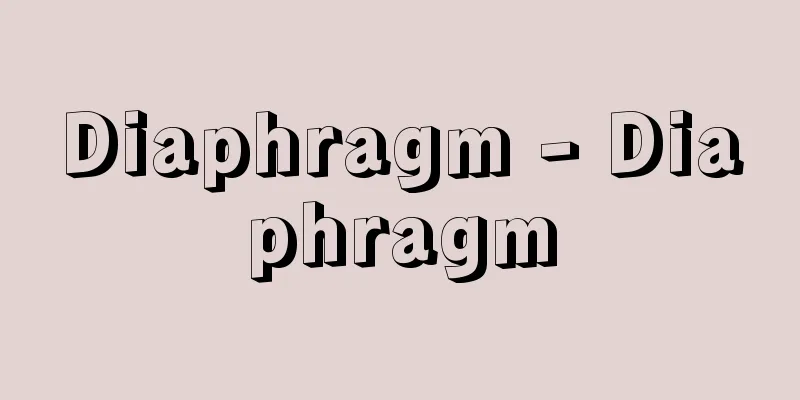Diaphragm - Diaphragm

|
The human diaphragm is a plate-like septum composed of muscles and tendons that forms the boundary between the thoracic and abdominal cavities. It is dome-shaped overall, with its convex surface corresponding to the floor of the thoracic cavity. The peripheral part of the diaphragm is made up of muscle fibers, which originate from the lumbar vertebrae, ribs, and sternum that form the lower opening of the thorax, form a dome, rise toward the thoracic cavity, and gather at and attach to a central aponeurosis (called the tendon center). Corresponding to the bony parts from which the muscle fibers originate, the muscle fibers are divided into the lumbar, rib, and sternal parts. The upper surface of the diaphragm is covered by the intrathoracic fascia and pleura, and the lower surface is covered by the diaphragmatic fascia and peritoneum, but there is no peritoneum where the abdominal organs come into contact. The dome-shaped diaphragm has a slightly higher right bulge than the left, but the height of the diaphragm differs between cadavers and living bodies, and also changes depending on breathing movements, the size of the liver, and the degree of distension of the stomach and intestines. In a cadaver with relaxed muscles, the apex of the right side of the diaphragm is at approximately the height of the fourth costal cartilage, which is the same height as when viewed from the ventral side during forced expiration. The position of the diaphragm is higher in women than in men, and higher in younger people than older people. It is said that the range of height movement during deep breathing is about 30 millimeters. The diaphragm has three holes for the organs that pass between the thoracic and abdominal cavities. The aortic hiatus is at the bottom and rear, the esophageal hiatus is in the muscular fiber area above and in front of the aortic hiatus, and the vena cava hiatus is at the top. There are also several small holes through which nerves and blood vessels pass. The nerve that controls the diaphragm is the phrenic nerve, which is mainly composed of fibers from the 4th cervical nerve, but also contains fibers from the 3rd and 5th cervical nerves. When the phrenic nerve is severed, the muscle fibers of the diaphragm relax, and the diaphragm, which had previously been contracted and tensed, rises toward the thoracic cavity. The organs surrounding the diaphragm are located above the center of the tendon on the thoracic surface, the heart, and the lungs on the left and right, and the liver, stomach, spleen, kidneys, and adrenal glands on the abdominal surface. [Kazuyo Shimai] Animal diaphragmThe diaphragm is a membranous accessory muscle that divides the body cavity of mammals into the thoracic cavity, which contains the lungs and heart, and the abdominal cavity, which contains the liver, stomach, intestines, etc. When the diaphragm contracts, the thoracic cavity expands, creating negative pressure inside and allowing outside air to enter the lungs. It also has the effect of increasing abdominal pressure during defecation and vomiting. The diaphragm is formed by the fusion of the ventral diaphragm on the ventral side and the dorsal diaphragm on the back side. Reptiles and birds also have diaphragms, but they do not completely separate the thoracic and abdominal cavities. A prototype of this can be seen in amphibians. [Masayuki Uchibori] [References] | |Source: Shogakukan Encyclopedia Nipponica About Encyclopedia Nipponica Information | Legend |
|
ヒトの横隔膜は胸腔(きょうくう)と腹腔(ふくくう)との境となっている、筋と腱(けん)とで構成されている板状の中隔である。全体として円屋根形で、凸面は胸腔の床にあたる。横隔膜の周辺部は筋線維からなり、胸郭(きょうかく)の下口を形成する腰椎(ようつい)、肋骨(ろっこつ)、胸骨からおこり、円蓋(えんがい)を形成して胸腔に向かって盛り上がり、中央部の腱膜(腱中心という)に集まって、これに付着する。筋線維がおこる骨部に相当して、筋線維は腰椎部、肋骨部、胸骨部に区分される。横隔膜の上面は胸内筋膜と胸膜、下面は横隔膜筋膜と腹膜に覆われるが、腹部臓器が接する部分には腹膜はない。横隔膜の円屋根形は右側隆起が左側よりやや高いが、横隔膜の高さは死体と生体では異なるし、呼吸運動や肝臓の大きさ、胃、腸の膨れぐあいでも変化する。死体で筋の弛緩(しかん)した状態での横隔膜の右側頂点は、ほぼ第4肋軟骨の高さで、これは、強制的な呼気を行わせたときの腹側からみた高さと同じである。横隔膜の位置は、女性では男性よりも高く、若い人は高年者よりも高い。また、深呼吸時における高さの移動範囲は約30ミリメートルという。横隔膜には、胸腔と腹腔との間を通る器官のための三つの孔(あな)がある。大動脈裂孔は最下後方にあり、食道裂孔は大動脈裂孔の前上方で筋線維部にあり、大静脈裂孔はもっとも上部にある。そのほか、神経や脈管を通すいくつかの小孔もある。 横隔膜を支配する神経は横隔神経で、第4頸(けい)神経線維が主となり、第3、第5頸神経からの線維も含まれる。横隔神経が切断されると、横隔膜の筋線維が弛緩し、それまで収縮緊張して下がっていた横隔膜は、胸腔に向かって上がる。横隔膜の周囲の臓器関係は、胸腔面には腱中心の上方に心臓、左右に肺が位置し、腹腔面では肝臓、胃、脾臓(ひぞう)、腎臓(じんぞう)、副腎が接している。 [嶋井和世] 動物の横隔膜哺乳(ほにゅう)類の体腔(たいこう)を、肺や心臓を含む胸腔と、肝臓、胃、腸などを含む腹腔とに区分する膜状の呼吸補助筋肉をいう。横隔膜が収縮すると、胸腔が広がって内部が陰圧となり、外気が肺に入る。そのほか排便や嘔吐(おうと)時に腹圧をあげる作用もある。横隔膜の形成は腹側の腹側隔膜と背側の背側隔膜の癒合による。爬虫(はちゅう)類や鳥類においても横隔膜はあるが、完全には胸腔と腹腔を境しない。両生類においてはその原型がみられる。 [内堀雅行] [参照項目] | |出典 小学館 日本大百科全書(ニッポニカ)日本大百科全書(ニッポニカ)について 情報 | 凡例 |
>>: Wang-xue zuo-pai (English spelling)
Recommend
Et
A discriminatory term for people who were classifi...
Tako [town] - Tako
A town in Sannohe County in the southern part of A...
Chaetognaths - Chaetognaths
In animal taxonomy, this group is a group of anim...
Tadamitsu Nakayama
A nobleman of the Sonno Joi faction in the late E...
Monastery of Hósios Loukas - Hósios Loukas Monastery
A Byzantine monastery in Greece, located about 20 ...
Occupational vibration-induced disease
What is the disease? Jackhammer ( Production ) Th...
Habit (song) - Habit
A term used in Noh. A type of utaiji. It is a narr...
Tsukesage - Tsukesage
A type of pattern arrangement for women's kimo...
Large-leaved Hosta - Large-leaved Hosta
→ Hosta Source : Heibonsha Encyclopedia About MyPe...
Sanpoukan (Citrus sulcata)
An evergreen tree of the Rutaceae family. It belon...
《Mémoire des pensées et sentiments de Jean Meslie》 (English notation) Memoire des pensées et sentiments de Jean Meslie
…He was a stubborn priest who refused to bow to t...
Screech - Screech
...It has many local names, such as Nirogi in Koc...
Inoceramus - Inoceramus
A genus of marine bivalve mollusks that flourishe...
Brown, Robert
Born December 21, 1773. Montrose, Angus [Died] Jun...
Sittenbild
…In English, it is called genre painting, in Fren...









